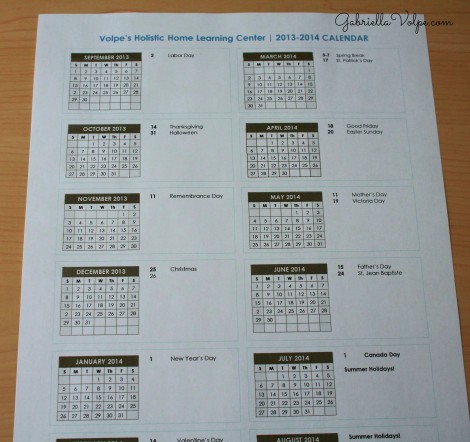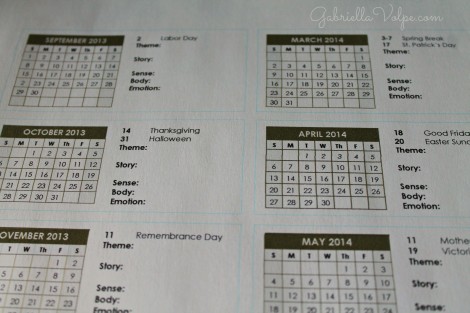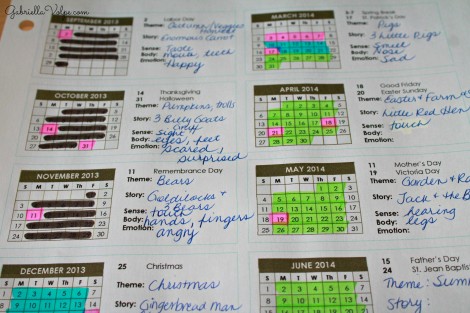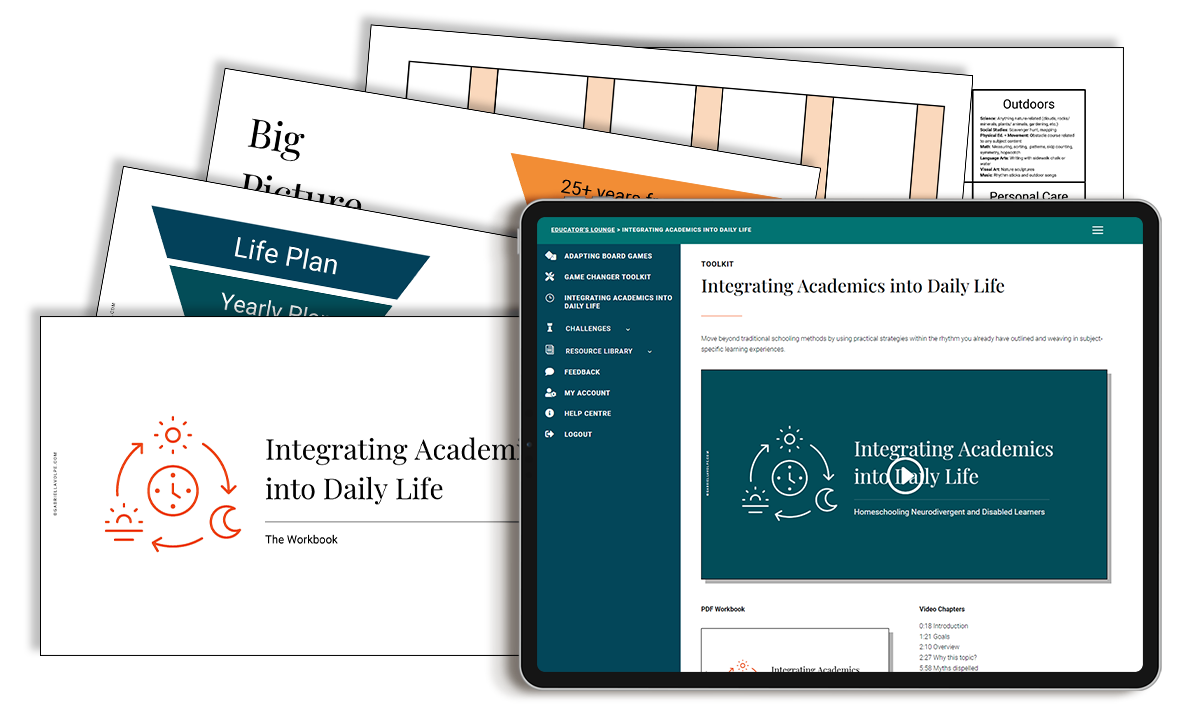I suggest you get started with these articles first if you haven’t already:
Part 1 – Outline your beliefs
Part 2 – Finding your child’s preferred “intelligence(s)” and learning style
Part 3 – Choosing a learning style
Part 4 – Locating the curriculum/program and finding resources
Part 5 – Adapting/Modifying the curriculum
Part 6 – Mapping out the year
Getting started with monthly homeschool planning
You will need a blank monthly template (see resources below). Alternatively, divide two notebook pages into six boxes or one page into 12 boxes. You want to have a blank space for monthly brainstorming.
You won’t be writing anything in stone here, so be flexible when using this as an outline. I’ve changed my mind several times, and there is leeway to adjust again.

I printed off a monthly calendar with boxes for brainstorming.
How to break up the monthly learning
By theme
The most obvious way to assign learning to each month is by theme. Working with the seasons and their respective holidays is the simplest way to begin. You might choose to make all of September “Apple Month,” all of October “Halloween Month,” all of December “Winter Holiday Month,” and so on.
By story/book
You may decide that you’d like to select a book/novel and work around that for the entire month. You can find many activities to keep you going all month long based on a story of choice.
By therapeutic recommendations
When you have a neurodivergent or disabled child, you have many recommendations from therapists/specialists for helping your child progress in one area or another. If you’ve included/combined some of the therapeutic suggestions in your child’s curriculum (part 5), then you have a lot to go by when planning for homeschooling.
In our case, we have SLP, OT, PT, and recommendations from our early childhood interventionist. Integrating specialists’ suggestions into our homeschool day is only logical for us. For one, it’s a time saver. I don’t need to feel pressured to do PT activities at the end of a long day.
If you choose to plan your year by allotting a few skills per month, you are not only making planning easier but also ensuring a more successful outcome.
Important note: Be sure the goals are neurodiversity- and disability-affirming. The idea is to create goals that reduce or remove barriers to learning, not to “fix” or change the child. Further, goals should always be set with and not for the child.
Mapping out the months
As a teacher, I can’t help but combine themes with books and therapeutic elements into our days. It is only difficult to do if I don’t map it out for myself.
Here’s an example of what I did when we first started homeschooling:
I used fairy tales as a starting point for my son’s learning each month. Considering the seasons and holidays, I selected books/stories that would best suit each month.
When I looked at our provincial educational program, I was able to make links to my son’s specialists’ recommendations. For instance, one standard/competency in the curriculum was “to affirm his/her personality.”
I combined the OT’s recommendations for feeding himself with that curriculum goal.
Now, if I were to try to do everything each specialist recommends on a daily basis, it would be draining. That’s why I recommend spreading the skills throughout the year—breaking them down each month.
These are the broader goals you can keep in mind when planning:
-
- Your child’s interests, needs, and desires
- OT’s suggestions
- PT’s suggestions
- SLP’s suggestions
- Psychologist’s suggestions
- Early interventionist suggestions
- Other specialists’ recommendations based on their latest evaluation
- The province/state curriculum/program (part 4)
Here are some possible specifics for you when planning the year (and breaking it down by month):
-
- OT: Feeding, using writing tools, preparing meals, dressing, washing hands, etc.
- PT: Walking, dancing, moving in place, using mobility aids, etc.
- SLP: Receptive language, expressive language, ASL, using AAC, etc.
- Personal goals: Exploring interests and passions in more depth, etc.
Important note: Be sure the goals are neurodiversity- and disability-affirming. The idea is to create goals that reduce or remove barriers to learning, not to “fix” or change the child. Further, goals should always be set with and not for the child.
Always check the most recent evaluations for specifics for your child.
An example:
In my son’s case, among our goals was building receptive language to include the names of body parts, the 5 senses, and emotions. For some of them, I included ALS signs. We kept building nouns and verbs, but since these other concepts were somewhat more abstract for him, I spread those concepts throughout the year and used the months/seasons as a guide.
For instance, when teaching the sense of taste, I tackled that in the autumn when we explored different spices in our food and drinks.

Since the calendar was editable, I added my own headings for each month—to be sure I kept those particulars in mind when brainstorming.
I plotted “sense of taste” in the month of September. Just because I put an emphasis on taste in September didn’t mean I didn’t refer to it throughout the year. It’s just that it was the perfect time of year to introduce it, and I kept reinforcing it throughout the season, and then throughout the year, I circled back to it.
I did the same with parts of the body and emotions. I tried to fit them into the most appropriate month as much as possible. Mapping things out in this way lets me be ahead of the game so that I can look for related activities or materials long before I have to implement them.

I highlighted the seasons based on my plan for the year (part 6). Then, I brainstormed for each month: the theme, the books/stories of choice, the senses, the body part, and the emotion I planned to focus on each month. I allowed myself room to change things as the year progressed.
Take time with this step. Peruse Pinterest for inspiration, and see what other teachers do at this time of year. Combine those ideas with your therapeutic recommendations, and voila! You’ve mapped out the months!
Resources:
- Monthly calendar template – Can be edited, available from July to June, August to July or September to August, free download
- Planning and Organizing – My Pinterest board with an ever-growing list of ideas and templates
Related Articles:
- Freebie: Your 3-Month Academic and Therapeutic Planning Guide
- Planning and Implementing Thematic Units (+ Freebie Unit Planner)
This step in the planning process might take the longest because you are gathering information from different sources and making it your own. I am available for individualized consultations if you need some help sorting through this.

Integrating Academics into Daily Life Workshop
Discover how to integrate academics into daily life. For homeschoolers of neurodivergent and disabled learners.

0 Comments